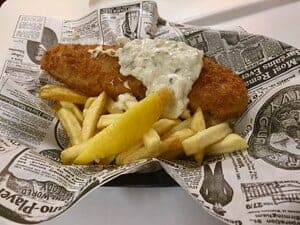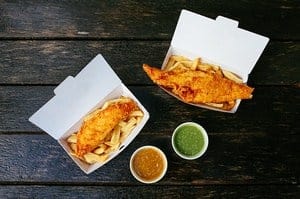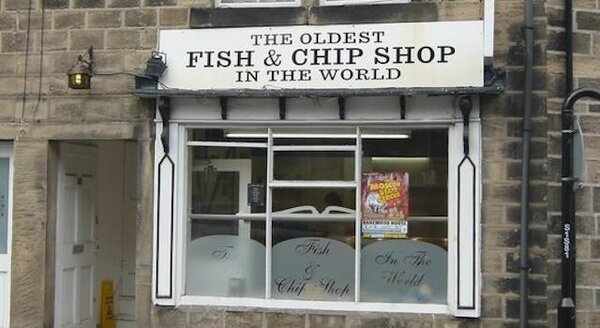As a Brit, Fish and Chips, our famous dish consisting of fried fish and large potato chips has always been a stable food. Or at least for the past 160 years.
We see it as an easy bite to eat on the road-side and as a comfort food to eat with the family.
The shops were opened in the 1860s, in London by Joseph Malin, a Jewish immigrant. He was the first to combine these two products together and perfect it. I also see this dish as very much part of my blood; my grandma’s family used to own fish and chip shops and it was one for the few foods not subject to rationing during the First and Second World Wars.
Everyone has their own favourite fish and chip shop or ‘chippy’ and most vary a little when it comes to what type of fish, what to accompany with it and the types of batters used.
The fish varies. In the north of the UK, for example, they mainly eat haddock whereas in the south cod is the preferred. In Scotland, it is automatically assumed you want haddock – unless you order something else.
But sometimes when I speak to tourists, they are not always impressed. When eaten in their own country, the taste is completely different, often using the wrong cooking techniques or types of fish. And when they come to the UK to try it, tourists often buy fish and chips in pubs or tourist traps, where us locals would never go.
So how should one pick the best fish and chips?
The location – the number one tip, which I cannot stress enough, is to go to a ‘Chippy’ or fish and chip shop/restaurant dedicated to this dish. Unless you are in a restaurant, you should be able to see them cook in front of you.
If it’s in a pub, no matter how beautiful it looks or how they say it’s ‘traditional’ it is highly doubtful that they will have the equipment and fryers necessary to make it fresh and so they’re buying it frozen. Or if the place sells other things such as kebabs, or burgers, again it will not be good quality. Good places only focus on one thing, fish and chips and nothing else.
Chips – For Brits, chips are our deep-fried potato that are much tastier and healthier than French Fries. Ask if they are triple-cooked chips, which involves first being simmered and cooled, drained, deep fried and again cooled, and finally deep fried again. Making the chips crispy on the outside but soft on the inside.
The Fish – has to be extremely fresh white fish, normally haddock or cod, but lots of people like rock salmon (a word that includes many species) or plaice.
Go where the Locals go – if you don’t see local people and just visitors to the UK that’s normally a sign it’s just a tourist trap.

The batter – The batter of the fish should be very light and crispy. Normally a golden and light brown colour. The best places use beer batter which adds bubbles giving a lightness to it. Hard batter usually means it’s not fresh, or was frozen. Some cook in Matzo Meal.
Vinegar – We Brits love to just add salt and vinegar to both the fish and the chips. The vinegar should be a malt vinegar, there are no balsamics, wine or cider vinegar with this dish. You can add as little or as much as you like. Many chip shops will do this for you.
Side dishes – there are many other side dishes to choose from but the most popular are mushy peas, pickles or some people pick a battered sausage. Items such as battered Mars Bars or battered pizza slices are really an ill thought out attempt at novelty.

Price – Normally expect to pay around £8 -£12 for a fish and chips if you are standing up, or £12-20 in a restaurant. If you are paying less than this, the quality will most likely not be great.
So there you have it, my top tips. But if you want to see the best fish and chips in London, why not come on our Secret Food Tours London and try it for yourself.
See you there!
